12/1/2022
Perfect Problem-Solvers: Native Plants
Matthew Olson

Native plants have progressed in our industry. Many homeowners viewed natives as weedy and not aesthetically pleasing only a few decades ago. Fast forward to 2022 and natives are one of the biggest trends among consumers. Several factors have led to the resurgence of natives, but the biggest reason may be their ability to solve problems.
Pictured: American Beauties Native Plants is a branded plant collection via a partnership between Prides Corner Farms in Lebanon, Connecticut, and North Creek Nurseries in Landenberg, Pennsylvania.
As pollinator numbers dwindle and natural disasters increase, consumers are looking for ways to use plants that tolerate fluctuating weather and encourage pollinators. Along with environmental benefits, natives add diversity and aesthetics to the landscape.
Education is Key
Selling natives is good, but helping consumers understand their benefits greatly increases sales and ensures customer satisfaction. One way to help your customers is to educate your employees. Understanding the products you sell is essential and natives are no exception.
Steve Castorani, president of North Creek Nurseries, says, “You need someone in the organization who is passionate about either native plants or birding. Birding is a good avenue to talk about native plants.”
Many native plants attract birds with edible seedheads, insects and a source of shelter. “Having a staff that is educated enough to tell the story of why native plants are important, their value and why they’re essential to have in the landscape,” is vital to selling natives, Steve adds. Emphasizing the value of native plants helps pollinators and endangered insects.
I spoke with Marta Lafaver, general manager of Buchanan’s Native Plants in Houston, to learn how retailers can educate consumers on natives.
“We do several events throughout the year, including seminars and classes. This past summer, we had our Top 5 sun natives and Top 5 shade natives, which was a huge class. People are hungry for that information,” she says.
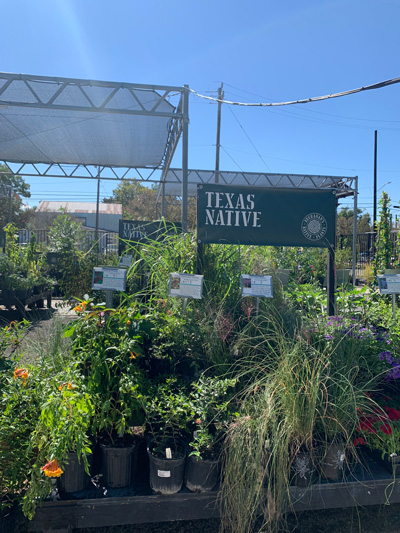 Pictured: Buchanan’s Native Plants in Houston, Texas, has been educating locals about native plants since 1986.
Pictured: Buchanan’s Native Plants in Houston, Texas, has been educating locals about native plants since 1986.
Another way to engage consumers is through your website. Blogs are a great way to educate consumers on natives and how to use these plants in their landscapes. You can also include information on native plant events on your website or in your newsletter. Buchanan’s uses their newsletter as a way of showcasing different species.
“We have a Native of the Week in our weekly newsletter, pointing out different natives people may not know about,” Marta says.
A Problem Solver
Native plants have the ability to solve problems. Many consumers struggle to grow plants in too dry or wet soil. They often have a shady spot they want to fill in, but don’t know the appropriate plants for those problematic sites.
Steve reminds us to see natives as problem solvers. “Even if you’re not selling native plants as native plants, you’re selling solution-oriented landscapes,” he says.
You can find native plants growing in almost any natural setting because they’re adapted to the local ecosystem. Consumers in northern landscapes often question the hardiness of their non-native plants, but native plants have a proven track record in their climate.
“The benefit is you’re selling them on landscape features, but they also have attributes that tie into ecology and help the wildlife in your yard,” Steve notes. Consumers often have an idea for their yard, but don't know the best way to make their plan a reality. Your knowledge is critical in making their vision come to life.
An example is rain gardens—a type of garden that often stays wet for extended periods. Understanding which natives thrive in wet areas goes a long way in helping consumers determine the right plant for the right place. Assisting consumers to make their vision a reality is satisfying for you and them.
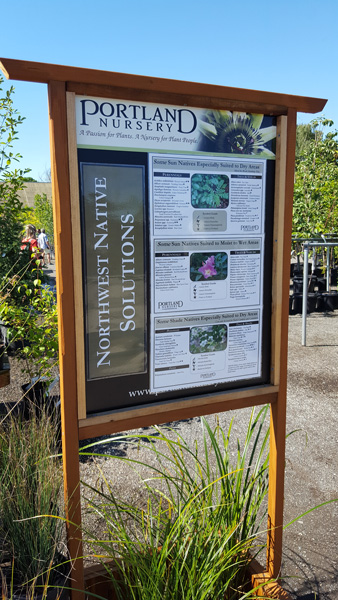
Drawing Attention to Natives
Retailers play a crucial role in promoting these valuable plants. You can use several methods to attract consumers to native plants in your garden center. Buchanan’s uses a variety of ways to bring attention to natives.
“We put them on a table and have a banner that says these are native plants. We know it will sell if we put it on our native plant table,” Marta says. Giving natives their own space lets you highlight their unique characteristics.
Pictured: This sign from a Portland Nursery location in Portland, Oregon, shows native solutions for wet and dry areas in the sun and dry areas in the shade.
Another way to help consumers find native plants is to set them apart from non-native plants. Customers often want several types of natives, and putting different species together makes them easy to find and more likely to sell. Highlighting the benefits of individual species is an effective way for people to observe the unique features of natives.
Bill Carter of Prairie Moon Nursery in Winona, Minnesota, has a few tips to attract customers to specific natives.
“Have fun with the showiest native grass—Prairie Dropseed,” he says. “Burn them off one at a time for customers on weekends or make a quick video and post it. This grass loves to be burned.”
Many retailers have onsite display gardens to demonstrate how plants perform in a landscape. Utilizing natives in a display garden gives customers a first-hand look at the plants they can grow. You can use signage in display gardens to educate consumers on each species and its ecological benefits. Creating a space for natives allows customers to observe pollinators and birds interacting with native plants. Bill suggests planting Liatris ligualistylis (Meadow Blazing Star) or Liatris scariosa (Blazing Star) to attract Monarch butterflies.What’s Trending?
It’s no secret natives are growing in popularity. Bill says, “Thirty years ago, even most gardeners were unfamiliar with the term ‘native plant.’ Now many kids in middle school are familiar with the plants and why we need to grow them.”
Several trends have emerged in recent years, including shrinking yards. Homeowners are looking for ways to diversify their lawn and incorporate natives in several ways. One method involves seeding a lawn with violets. Bill notes, “We cannot produce enough violet seed to meet the demand.”
Consumers are reducing the size of their yards by creating native plant beds, which require less maintenance and offer improved aesthetics. The number of native plant enthusiasts is rapidly growing. For example, the Native Plant Gardeners of the Upper Midwest Facebook group has more than 12,000 members. Many other groups exist on social media as well.
The reasons consumers grow native plants have been evolving in the last decade. Marta at Buchanan’s notes, “In the past 10 years, interest has grown in bee and pollinator plants, the Monarch craze happened and now we’re getting into the bee craze.”
Consumers are using natives for permaculture gardens to work with nature and increase biodiversity in their landscapes. Marta adds, “We have seen a lot more of the Korean natural farming, regenerative gardening and foodscapes. Mixing native pollinator plants with any of those really increase your yield.”
As consumer interest grows, consider how to promote natives in your business. The bees and birds (and your customers) will thank you.
Hot Natives by Region
Native plants come in various sizes, shapes and colors. Each plant is unique, but a few species stand out in different regions of the country. Here are a few notable natives from around the country.
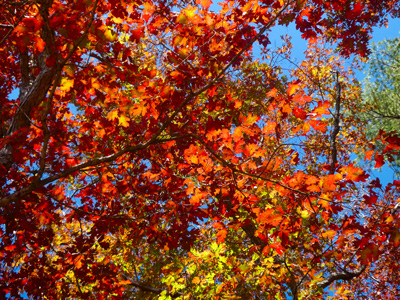 Midwest/East
Midwest/East
White Oak (Quercus alba) Zones 3 to 9
This shade tree is native to the eastern U.S., making it useful for consumers in various climates. The oak genus is crucial, as it supports many insects, birds and mammals. They’re incredibly hardy and withstand the far north and deep south conditions. White Oak and other oaks require ample space to grow and thrive. This genus is known for its long-lived trees and landscape durability.
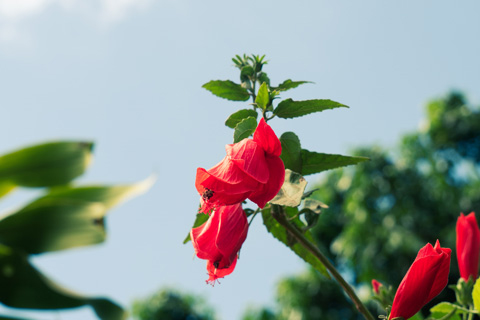 South
South
Turk’s Cap (Malvaviscus arboreus var. drummondii) Zones 7 to 10
Turk’s Cap is a member of the mallow family and is a popular shrub for hummingbirds. The bright red flowers resemble hibiscus flowers, but the flowers stay closed, creating a “turban-like” effect. This shrub can be grown in various soil types and is drought-tolerant once established. It’s known for its long bloom season, which extends through summer into fall. You can grow them in full sun and shade, making them a versatile choice in the landscape. A bonus feature is the fruit, which taste like cucumbers.
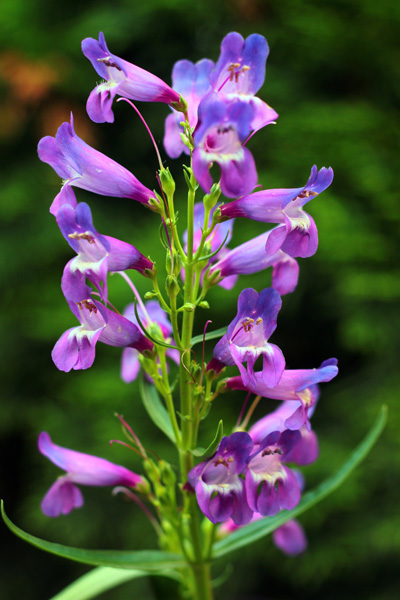 West
West
Rocky Mountain Penstemon (Penstemon strictus) Zones 3 to 8
This spring-blooming perennial is native to the Rocky Mountain region, from Wyoming to New Mexico. The highlight of this plant is the purple flowers and their ability to withstand extreme conditions. Unlike many penstemon, this species can tolerate heavier soils, however, it grows best in light, well-draining soil. In the wild, you can find it growing in conifer forests or brush areas. This species is a beautiful addition to rock gardens and natural landscape beds. Like many natives, It attracts pollinators and hummingbirds. GP
Matthew Olson is a professional horticulturist and garden writer. He regularly writes articles about gardening for consumers and industry professionals. You can reach him at matt@mattolsonhorticulture.com.